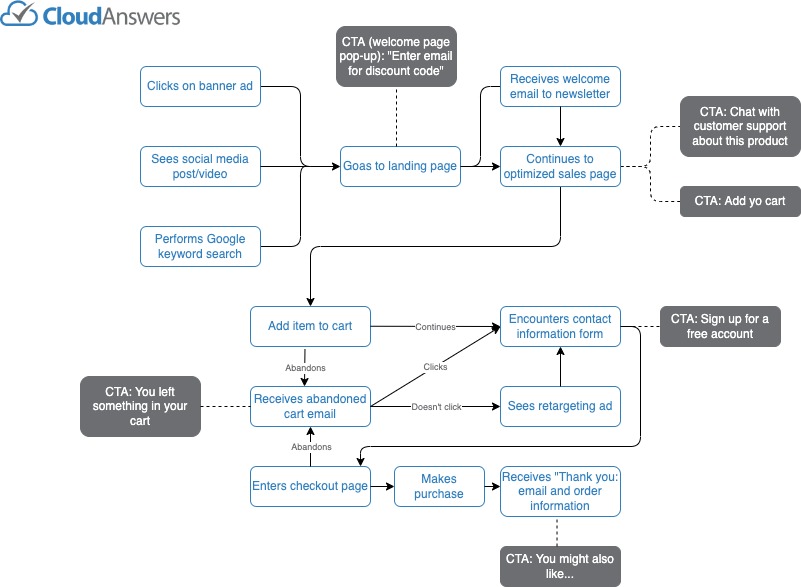Lead nurturing is all about discovering what your customers value and then offering it to them in an automated fashion and watching their behavior to see when they are ready to purchase or get involved with sales. Lead nurturing includes identifying their needs and giving value to potential customers throughout their interactions with your organization. That is encouraging leads to stay in touch until they are ready to take the next step.
Depending on your marketing automation system, the specific instructions on how to set up a lead nurture campaign can vary. Historically, this was done with just email, but lately, most campaigns have become multi-modal including text messaging, calling, and other social media. In this post, we’ll discuss the key components of lead nurturing and show a few examples.
What is Lead Nurturing?
Lead nurturing is a procedure of engaging and developing relationships with customers through each customer journey stage. A lead nurturing campaign aims to qualify leads further and guide them to a successful sales solution.
Using website content, nurturing flows can provide value to potential consumers. A personalized email flow, for example, may help create confidence in your business and get potential customers closer to completing a purchase by offering additional resources.
Here’s how lead nurturing differs from email marketing: the goal of a lead nurture flow is to keep the lead warm, educate your audience, to meet their needs, not just to sell them products or services. Lead nurture flows are behavior-based, meaning they change depending on what the customer does on the website or in the online store. Instead of promoting “timely” offers in response to out-of-store events and seasonal campaigns, they are based on what the customer wants to know and what they expect from us.
Results are impressive. Lead nurturing creates more sales, but it also closes bigger deals. Lead nurturing drives more sales and revenue in a shorter period. Forrester Research reports that companies that excel at lead nurturing generate 50% more sales-ready leads at 33% lower cost. Nurtured leads spend as much as 47% more than non-nurtured leads, according to The Annuitas Group.
Example Nurture Campaign Flow Charts:
Traditional Sales Model – Lead Nurturing

eCommerce Nurture Flow
This generic eCommerce flow just shows a very simple email nurturing campaign.

B2C eCommerce Nurture Flow
In this flow, there are on-page pop-ups, emails, and social media retargeting ads to reduce the number of people dropping out of the funnel.

What Makes Lead Nurturing Successful?
Marketing goals are essential for your business. However, your goals should be aligned with meeting your customers’ needs. If you create content that meets their needs and get it to them at the right time it will help you build a strong lead list and increase conversions. When you get to know your audience’s behavior and figure out where they are in the buying process, you’ll be able to grow your relationship with them.
It is safe to conclude that the above strategies show that you should be everywhere. There is no one fool-proof technique for all leads, but you can evaluate leads based on their behavior and continually refine your process and learn from your results.
Nurture Flow Reporting
When creating an effective nurture flow, the best practice is, as already mentioned, to have great content and an automated process. But to develop great content, you’ll need to develop what you think is great, then measure how well it works in the real world and continue to refine the process and the content over time while continuously creating new content.
So, when creating your reports, consider some of the following metrics:
- For the overall nurture campaign, how is your goal rate over time? In other words, out of everyone that goes into this campaign, how many meet your goal criteria (purchase, schedule meeting with sales, etc)?
- For emails, what are their open and click-through rates?
- For ads and on-page pop-ups, what are the click-through rate and the overall number of clicks and impressions?
- Where are the spots in the nurture campaign where the conversion rate is low?
- Which pieces of content are driving the most leads entering the nurture campaign?
If you don’t have a solution already, Salesforce offers easy-to-use, powerful tools for lead nurturing, including a marketing automation solution called Marketing Cloud Account Engagement. Marketing Cloud Account Engagement helps marketers align with sales and understand which marketing efforts drive revenue. With Marketing Cloud Account Engagement, you can track your prospects and deals with lifecycle reporting and Individual Prospect Lifecycle Report, which is available at Reports ->Lifecycle.
If you’re using standard Salesforce campaigns to track your Lead nurturing then you can review the stats on the campaign itself, or run some standard reports to view the performance. You can get a lot of the metrics above from a standard Campaigns report, although you may have to go to your email marketing system or website content management system for performance metrics on web content, chat messages, ads, and emails. For more advanced reporting, consider using Flows to update fields on the Lead based on things like when they go from Nurture status back to working status. These fields can then be added to your reports for even more insights, such as how many times Leads get nurtured.
If you need to schedule and send your reports outside the Salesforce environment, check out our Report Sender app, it’s free to send reports in CSV format for other people to get the campaign stats.
What Next
If you’re considering implementing or improving a Lead Nurturing program for your organization, we recommend you first sit down and design the flow that you want to be based on your particular lead sources, sales process, and marketing technology. After that, implement your solution, measure the results and continue to tweak it over time until you have a consistent new source of sales leads or revenue!
